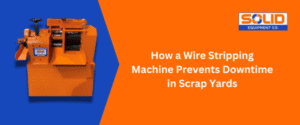Scrap yards run on speed, volume, and efficiency. When operations stall, revenue takes a hit. That’s why the used wire stripper is more than just a piece of scrap yard equipment—it’s a frontline tool in the fight against downtime. Wire stripping machines are engineered to remove insulation from copper and aluminum wire fast and clean. But their real value lies in how they help keep everything else moving. Below, we break down how a wire stripping machine prevents downtime, boosts productivity, and protects your bottom line.
The Cost of Downtime in Scrap Yards
Every minute a machine sits idle costs money. Downtime in industrial operations can cost thousands per hour, and scrap yards are no exception.
Common downtime triggers:
- Clogged shredders or granulators due to improperly stripped wire
- Manual bottlenecks in processing insulated cables
- Delayed shipments due to slow wire prep
- Excessive wear and tear on high-impact equipment
- Labor shortages or injuries caused by manual stripping
A used wire stripper for scrap yards helps neutralize these problems before they start.
How a Used Wire Stripper Improves Efficiency
-
Fast and Consistent Output
A quality wire stripping machine can process hundreds of feet of wire per hour, far outperforming manual methods. Whether you’re recycling copper or aluminum, it cuts insulation cleanly and consistently—no delays, no backups.
-
Less Wear on Shredders
Feeding insulated wire directly into shredders increases the risk of clogging and accelerates equipment damage. Pre-stripped wire keeps your granulators and separators running smoothly and reduces the chance of unplanned repairs.
-
Reduced Labor Dependency
Manual stripping is slow, unsafe, and not scalable. A used wire stripper reduces your reliance on manual labor while increasing output.
-
Better Material Value
Clean copper and aluminum fetch higher prices. A cable stripper ensures every pound of wire is maximized for resale.
Choosing the Right Used Wire Stripper
Not all wire strippers are created equal. To get the most out of your investment, you need the right tool for your volume and material type
| Factor | What to Consider |
| Wire Type | Copper, aluminum, mixed gauge |
| Volume | Daily throughout in pounds/feet |
| Insulation Type | Thick rubber, plastic, or thin film |
| Feed Style | Manual, automatic, multi-channel |
| Budget | Look for affordable used wire strippers with strong ROI |
For more details, check out how to choose the right used wire stripper.
Practical Tips to Maximize ROI
- Buy Used, Not New: A used wire stripper for copper and aluminum wire delivers the same performance at a fraction of the price.
- Match Machine to Volume: Don’t under- or overspend—make sure your equipment scales with your yard’s needs.
- Prioritize Durability: Opt for machines designed for heavy-duty use to minimize breakdowns.
- Partner with Reliable Suppliers: Choose vendors like Solid Equipment Company for trusted brands and ongoing support.
Don’t Let Your Yard Stall
If you’re serious about throughput, it’s time to rethink your workflow. A used wire stripper is one of the smartest additions to your scrap yard equipment lineup. It keeps your operation lean, fast, and productive—while saving you money on repairs, labor, and downtime.
Ready to upgrade? Start with the experts at Solid Equipment Company, or browse their used recycling equipment to find an affordable used wire stripper for heavy-duty applications that fits your needs.
FAQs
What’s the best used wire stripper for recycling operations?
The best model depends on your throughput and wire type. For high-volume yards, automatic multi-channel models offer superior efficiency. See the full product gallery for options.
How does a wire stripping machine prevent downtime?
It removes insulation quickly and cleanly, preventing jams in shredders, reducing manual bottlenecks, and increasing processing speed—all key factors in uptime.
Can a used wire stripper handle all wire types?
Many models can handle a wide range, from small gauge electronics wire to thick cable. But check the specs—some are optimized for certain materials or insulation types.

